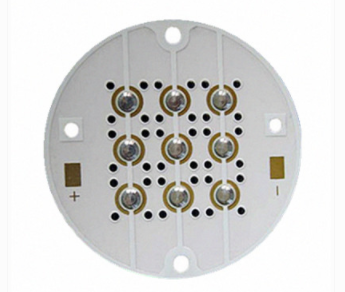What are the characteristics of aluminum substrates
Aluminum base plate (metal base heat sink (including aluminum base plate, copper base plate, iron base plate)) is a low-alloyed Al-Mg-Si series high-plasticity alloy plate, which has good thermal conductivity, electrical insulation properties and mechanical processing properties. Compared with the traditional FR4 fiberglass circuit board, the aluminum substrate adopts the same thickness and the same line width. The aluminum substrate can carry higher current. The aluminum substrate can withstand voltage up to 4500V and the thermal conductivity is greater than 2.0. Aluminum is used in the industry. Mainly based on substrate.
Using surface mount technology (SMT);
1. Extremely effective treatment of thermal diffusion in the circuit design scheme;
2. Reduce product volume, reduce hardware and assembly costs;

3. Reduce product operating temperature, improve product power density and reliability, and extend product service life;
4. Replace the fragile ceramic substrate to obtain better mechanical durability.
Aluminum-based copper clad laminate is a metal circuit board material, composed of copper foil, thermally conductive insulating layer and metal substrate. Its structure is divided into three layers:
Cireuitl.Layer circuit layer: the copper clad laminate equivalent to ordinary PCB circuit boards, the thickness of the circuit copper foil is loz to 10oz.
BaseLayer base layer: is a metal substrate, generally aluminum or copper can be selected. Aluminum-based copper clad laminates and traditional epoxy glass cloth laminates, etc.
DielcctricLayer insulating layer: The insulating layer is a layer of low thermal resistance and thermally conductive insulating material. Thickness: 0.003" to 0.006" inches is the core technology of aluminum-based copper clad laminates, which has obtained UL certification.
Compared with other materials, PCB circuit board materials have incomparable advantages. Suitable for surface mount SMT public art of power components. No radiator is needed, the volume is greatly reduced, the heat dissipation effect is excellent, and the insulation performance and mechanical performance are good.
The LED die substrate is mainly used as a medium for exporting heat energy between the LED die and the system circuit board, and is combined with the LED die through the process of wire bonding, eutectic or flip chip. Based on heat dissipation considerations, the LED die substrates on the market are mainly ceramic substrates, which can be roughly divided into three types: thick-film ceramic substrates, low-temperature co-fired multilayer ceramics, and thin-film ceramic substrates. For high-power LED components, thick-film or low-temperature co-fired ceramic substrates are mostly used as die heat dissipation substrates, and then the LED die and the ceramic substrate are combined with gold wires.
As mentioned in the introduction, this gold wire connection limits the effectiveness of heat dissipation along the electrode contacts. Therefore, major domestic and foreign manufacturers are all working hard to solve this problem. There are two solutions. One is to find a substrate material with high heat dissipation coefficient to replace alumina, including silicon substrates, silicon carbide substrates, anodized aluminum substrates or aluminum nitride substrates. Among them, silicon and silicon carbide substrates are semiconductor materials. Due to its characteristics, it has encountered more severe tests at this stage, and the anodized aluminum substrate is prone to conduction due to chipping due to the insufficient strength of the anodized oxide layer, which limits its practical application. Therefore, at this stage The more mature and generally accepted one is to use aluminum nitride as the heat dissipation substrate;
However, the current limitation is that the aluminum nitride substrate is not suitable for the traditional thick film process (the material must be heat-treated in the atmosphere at 850°C after the silver paste is printed, which causes material reliability problems). Therefore, the aluminum nitride substrate circuit needs a thin film process Prepared. The aluminum nitride substrate prepared by the thin-film process greatly accelerates the efficiency of heat from the LED die through the substrate material to the system circuit board, thus greatly reducing the burden of heat from the LED die to the system circuit board through the metal wire, thereby achieving high heat dissipation Effect.